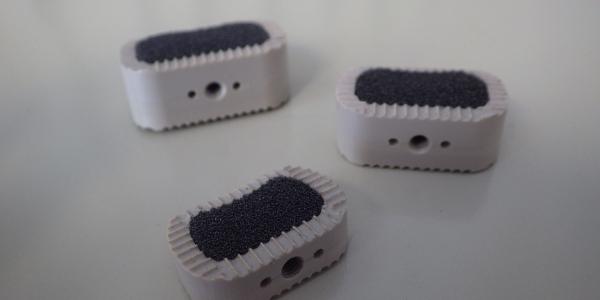No Bones About It
Imagine if the need to amputate injured limbs were a thing of the past. The notion is not so far-fetched, thanks in part to collaborative research by scientists perfecting technology derived from the aerospace industry.
Preclinical trials using composite materials ordinarily found on airplanes have successfully demonstrated the regrowth of bone in small and large animal models, says Joel White, a biomedical research engineer at the National Center of Innovation for Biomaterials in Orthopaedic Research (CIBOR) at Wichita State University’s National Institute for Aviation Research (NIAR).
The center’s research is one of several collaborative endeavors between aerospace and medicine happening in Wichita, an aerospace hub that lures many companies with expertise in composites, says Kim Reuter, senior research engineer at CIBOR.
The meshed fields gave rise to the center, founded in 2009 when Wichita State scientists and executives teamed with Via Christi, the state’s largest health system, to capitalize on the idea that polymer composite materials developed for the aerospace industry could meet medical needs. Composites tend to enhance the performance of industrial, medical and prosthetic devices and usually are stronger yet lighter than monolithic materials.
“The medical industry is starting to get into composites and finding unique aspects and ways to take advantage of composite material,” says Reuter, whose work concentrates on preserving bone from the onset of injury. “In our organization, the goal is to take the expertise that has been developed in the aerospace industry and translate that to the medical industry.”
That mission did not get lost in translation as scientists sought a synthetic bone graft substitute and discovered a rigid carbon foam that can stimulate regrowth of natural bone with fewer harmful effects than current products, White offers. Such breakthroughs in regrowth technology could significantly aid wounded warriors, patients suffering from spinal injuries and those needing maxillofacial or oral surgeries, he says.
The foam resembles trabecular bone, or spongy bone, and is not cytotoxic, so the body does not react to it, White says.
It “helps jump-start the bone-forming process when we are using our material,” he shares. “We’ve had very positive results in multiple animal studies,” including in small animals and sheep with critical size defects, or large breaks or lacerations that will not heal on their own.
In addition to stimulating bone regrowth, the carbon foam material shows promise in reducing doses of osteoinductive bone morphogenetic protein 2, or BMP2, which clinicians use to promote bone repair. High concentrations of BMP2 can lead to new bone growth that is weak because the bone lacks mass, and the protein can extend beyond the area where it is needed, White explains. “We were able to reduce the dosage from what is clinically relevant by an order of magnitude and still get the same result, if not better, when we paired it with our carbon foam material. Being able to reduce the dosage as well as hold on to the BMP better so that it binds onto our material means it is much more localized, and we are able to better control where and how it is used,” he says.
White, who focuses on technology that helps in the aftermath of traumatic injuries, and other scientists at CIBOR have worked with the carbon foam for roughly five years. CIBOR-based scientists hold two patents on the material, which has applications in electronics and machining as well. Although the researchers are keyed up to launch new phases of clinical studies, they are not quite ready to begin seeking manufacturing partners.
The scientists, who concentrate on post-traumatic fixes as much as prevention of severe trauma, are moving forward with developing a fast-setting composite splint that not only is lightweight, compact and easily portable but also adequately supports injured limbs. In 2011, CIBOR received a $1.4 million grant from the U.S. Army Medical Research and Materiel Command to find a replacement for the service’s splint, which while lightweight and portable, did not provide ideal stabilization, Reuter says. “When an injured soldier is removed from the field, if the injury is not immobilized very well, you could have increased [neurological] and vascular damage. The idea is to provide better stabilization to reduce additional neuro and vascular damage from the movement of the sharp bone shards,” she says.
The composite splints initially are flexible, but when applied to an injury, they rapidly harden, taking the shape of the wounded limb in just 40 seconds. “When they cure, they become very rigid and stiff, almost like creating an exoskeleton for the limb,” Reuter explains. The composite splint works in hot, cold, wet and dry environments, and tests show it is twice as stiff and four times as strong as current devices.
“We also did biomechanical testing with analog limbs, or dummy limbs, and the results were positive,” she continues. “We outperformed the current device in those tests as well.”
Wichita-based emergency medical personnel are now testing the splints before Army officials determine whether to add them to medical kits.





Comments